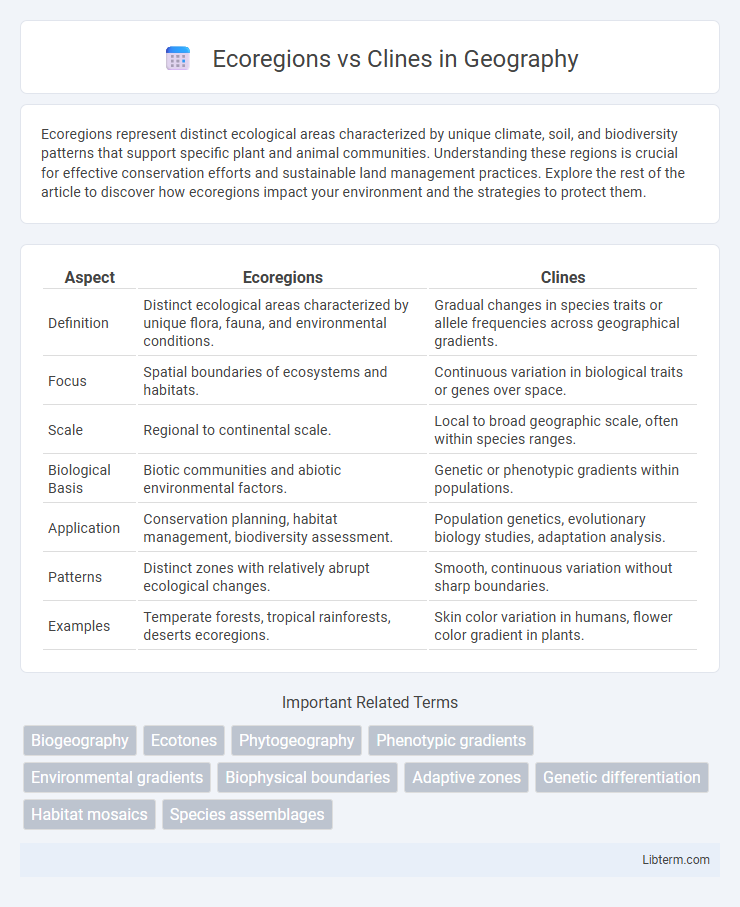Ecoregions represent distinct ecological areas characterized by unique climate, soil, and biodiversity patterns that support specific plant and animal communities. Understanding these regions is crucial for effective conservation efforts and sustainable land management practices. Explore the rest of the article to discover how ecoregions impact your environment and the strategies to protect them.
Table of Comparison
| Aspect | Ecoregions | Clines |
|---|---|---|
| Definition | Distinct ecological areas characterized by unique flora, fauna, and environmental conditions. | Gradual changes in species traits or allele frequencies across geographical gradients. |
| Focus | Spatial boundaries of ecosystems and habitats. | Continuous variation in biological traits or genes over space. |
| Scale | Regional to continental scale. | Local to broad geographic scale, often within species ranges. |
| Biological Basis | Biotic communities and abiotic environmental factors. | Genetic or phenotypic gradients within populations. |
| Application | Conservation planning, habitat management, biodiversity assessment. | Population genetics, evolutionary biology studies, adaptation analysis. |
| Patterns | Distinct zones with relatively abrupt ecological changes. | Smooth, continuous variation without sharp boundaries. |
| Examples | Temperate forests, tropical rainforests, deserts ecoregions. | Skin color variation in humans, flower color gradient in plants. |
Introduction to Ecoregions and Clines
Ecoregions represent geographically distinct areas characterized by specific environmental conditions, flora, and fauna, providing a framework for biodiversity conservation and ecosystem management. Clines describe gradual changes in species' genetic or phenotypic traits across geographical gradients, reflecting adaptation to varying environmental pressures. Understanding ecoregions and clines aids in interpreting ecological patterns and evolutionary processes at different spatial scales.
Defining Ecoregions: Boundaries and Characteristics
Ecoregions are distinct geographic areas defined by homogeneous environmental conditions, such as climate, vegetation, and soil types, which create unique ecosystems with specific flora and fauna. Boundaries of ecoregions are typically delineated based on abrupt changes in these ecological factors, separating one biological community from another. Unlike gradual variations seen in clines, ecoregion boundaries reflect ecological discontinuities that guide conservation and land management practices.
Understanding Clines: Continuous Variation Across Landscapes
Clines represent gradual, continuous variations in genetic or phenotypic traits across geographical landscapes, reflecting adaptive responses to environmental gradients such as temperature, altitude, or humidity. Unlike discrete ecoregions, clines emphasize smooth transitions without clear boundaries, capturing evolutionary processes and natural selection in real-time. Studying clines provides insights into species adaptation, gene flow, and biodiversity patterns across heterogeneous environments.
Key Differences Between Ecoregions and Clines
Ecoregions represent distinct geographic areas defined by environmental conditions, such as climate, soil, and vegetation, resulting in relatively homogeneous ecosystems. Clines describe gradual changes in the genetic or phenotypic traits of populations across a geographical gradient, reflecting adaptive responses to varying environmental pressures. Unlike ecoregions, which are spatially bounded and discrete, clines illustrate continuous variation without clear-cut boundaries.
Methods for Mapping Ecoregions and Clines
Mapping ecoregions involves the integration of satellite imagery, climate data, and vegetation classification to delineate discrete ecological zones characterized by consistent environmental conditions and biological communities. Clines are mapped using genetic sampling across geographic gradients combined with statistical models like spatial autocorrelation and principal components analysis to detect gradual changes in allele frequencies or phenotypic traits. Geographic information systems (GIS) facilitate the overlay and comparison of ecoregion boundaries with clinal variation patterns, enhancing the understanding of spatial biodiversity dynamics.
Ecological Significance of Ecoregions
Ecoregions represent distinct geographic areas characterized by specific ecological features, such as climate, soil types, and vegetation, which influence biodiversity patterns and ecosystem processes. Their ecological significance lies in providing a framework for conservation planning, resource management, and understanding species distribution and habitat connectivity. Unlike clines, which describe gradual genetic or phenotypic variations within species populations, ecoregions emphasize holistic environmental context and ecosystem-level relationships.
Evolutionary Implications of Clines
Clines represent gradual changes in allele frequencies or phenotypic traits across geographical gradients, reflecting ongoing gene flow and local adaptation in populations. The evolutionary implications of clines include the maintenance of genetic diversity and the potential for speciation as populations experience selective pressures varying by environment. Unlike discrete ecoregions, clines illustrate continuous evolutionary processes shaped by spatial environmental heterogeneity and migration patterns.
Case Studies: Real-World Examples of Ecoregions and Clines
The Amazon Rainforest ecoregion exemplifies rich biodiversity with distinct ecological boundaries shaping unique species assemblages, while bergmann's rule illustrates a cline where body size increases with latitude in animals such as the North American deer mouse. Studies on the Great Barrier Reef ecoregion reveal zonation patterns affecting coral species distribution, contrasting with human skin pigmentation clines that demonstrate gradual genetic adaptation to varying UV radiation levels across continents. These real-world examples highlight the difference between discrete ecoregions defined by environmental factors and continuous clines marked by gradual phenotypic or genetic variation.
Applications in Conservation and Environmental Management
Ecoregions provide a spatial framework for conservation by defining large areas with distinct ecological conditions and species assemblages, enabling targeted habitat protection and restoration efforts. Clines characterize gradual genetic or phenotypic variations within species across environmental gradients, informing adaptive management and the design of conservation strategies that preserve genetic diversity. Integrating ecoregions and clines enhances environmental management by aligning habitat conservation with evolutionary processes, promoting resilience to climate change and anthropogenic impacts.
Conclusion: Integrating Ecoregions and Clines in Ecology
Integrating ecoregions and clines enhances ecological understanding by combining spatially defined environmental zones with gradual genetic or phenotypic variations across populations. This approach facilitates more precise biodiversity conservation strategies, allowing for adaptive management that considers both habitat-specific factors and continuous evolutionary changes. Recognizing the interplay between discrete ecoregions and continuous clines is essential for predicting species responses to climate change and environmental gradients.
Ecoregions Infographic

 libterm.com
libterm.com